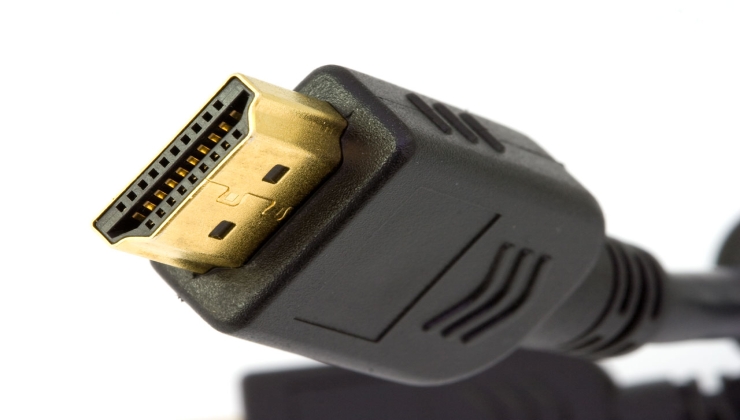- cross-posted to:
- [email protected]
- cross-posted to:
- [email protected]
What’s the over/under that this was about preventing people getting around HDCP using a modified driver?
DisplayPort supports HDCP as well though?
FRL != HDCP. I think HDCP works on Linux already?
VESA or bust
This sucks as all new TVs use HDMI2.1 for modern features and modern games consoles rely on those for 4k 60Hz HDR, etc.
So now Valve can’t just make their own home console with Steam OS for TVs directly (and support high-end features at least).
I believe this is specifically for FRL. Other features should still work afaik.
If we had to relay exclusively on non-proprietary protocols, I doubt that GNU/Linux would have gone anywhere beyond the Commodore 64
Why? Most software wasn’t proprietary before companies realized they could make more money at your expense (not all the profit is going into making a better product).
If given the choice of an uncomfortable dormitory or a comfortable jail, at least the residents can improve the living areas in the former.
Parent is right though. Unix being proprietary is why the GNU project was started, and why the Linux kernel and BSDs rose above.
Hopefully HDMI being proprietary leads to others creating an alternative, open standard which eventually can push HDMI to open up or push it out.
Isn’t that what DisplayPort is? At least that is what Dell is claiming.
VESA requires an annual membership fee to access the DP standard. Perhaps that’s fine but that makes regular people unable to “open” the door to the standard.
VESA has in the pastclaimed implementing DP can mean you own them royalty feesbut they apparently backed down from that.Implementation of Content ““Protection”” isn’t in the spirit of an open standard to me, rather the opposite. Why have an open standard if not to weed-out corporate anti-features from existence for the benefit of the users?
Alright this sent me down a rabbit hole so I’m going to try to and summarize really quickly.
1st, VESA requires a membership but in reality you need a company that has a vested interest in what VESA does. So you have to pay a huge due to be apart of it. This is quite BS according to me, the fact that they can do this and still claim to be an open standard. Source
2nd, VESA never tried to implement a royalty based off the Display Port Standard. The company that did that was MPEG LA, LLC, they aren’t affiliated with VESA. Rather this company is a patent pool company that attempted to enforce their clients (such as Sony) licensing fees. They seemed to have backed off of this back in 2016 as the last patent used was for the Display Port Standard 1.4. Source
3rd Content Protection was necessary if you want wide spread adoption. Companies aren’t going to want to do business with you if you allow for their IP to be ripped. As well, VESA is just a collection of companies that have voting shares in the company. So those corporate features are just par for the course.
Corporate Protection in MY hardware is a hill I’d die on, wide spread adoption be damned if not possible without it.
indeed, parent’s conflation of C64 and *nix threw me off (as I guess it did others), but your comment helps to put it into perspective.
proprietary can drive FLOSS innovation, but its so hard to get around proprietary entrenchment - especially wrt consumer facing tech.
Linux never ran on the Commodore 64 (1984). That was way before Linux was released by Linus Torvalds (1991).
I’d also like to point out that we do all rely on non-proprietary protocols. Examples you used today: TCP and HTTP.
If we didn’t have free and open source protocols we’d all still be using Prodigy and AOL. “Smart” devices couldn’t talk to each other, and the world of software would be 100-10,000x more expensive and we’d probably have about 1/1,000,000th of what we have available today.
Every little thing we rely on every day from computers to the Internet to cars to planes only works because they’re not relying on exclusive, proprietary protocols. Weird shit like HDMI is the exception, not the rule.
History demonstrates that proprietary protocols and connectors like HDMI only stick around as long as they’re convenient, easy, and cheap. As soon as they lose one of those properties a competitor will spring up and eventually it will replace the proprietary nonsense. It’s only a matter of time. This news about HDMI being rejected is just another shove, moving the world away from that protocol.
There actually is a way for proprietary bullshit to persist even when it’s the worst: When it’s mandated by government.
AV1 is a good example of a non-proprietary protocol replacing proprietary protocols (h.264, h.265, …)
DRM is mandatory in any spec you expect content owners to support. We don’t have to like it, but it’s absolutely not going away.
There are couple of ways, not buying the content for example. DRM is for paying customers.
That’s 99% of the reason we use HDMI…
Who is we?
deleted by creator
This is the best summary I could come up with:
If you were hoping at some point to see HDMI 2.1+ on Linux with AMD + Mesa, you’re out of luck right now as it’s simply not going to be happening.
There’s been a bug report on the Mesa GitLab of “4k@120hz unavailable via HDMI 2.1” that’s been open for a few years now, with lots of comments and chatter about the issue.
In an update on the bug report, AMD engineer Alex Deucher commented: "The HDMI Forum has rejected our proposal unfortunately.
So if you’re on Linux, it’s going to continue to be best to buy hardware that uses DisplayPort.
On the NVIDIA side though, it seems like it may not be an issue, as developer Karol Herbst wrote on Mastodon: "Even though AMD might not be able to add support for HDMI 2.1, nouveau certainly will as Nvidia’s open source driver also supports HDMI 2.1 so there is no reason to believe that at least some drivers can’t support HDMI 2.1
It’s quite backwards, but apparently having all the logic inside firmware (like Nvidia does) will probably help us implementing support for HDMI 2.1"
The original article contains 244 words, the summary contains 183 words. Saved 25%. I’m a bot and I’m open source!
DisplayPort for life!
That doesn’t do audio too though right?
It does since version 1.0 it seems?
TIL
Thank God, for a moment I thought I had auditory hallucinations.
Visual are ok though
Is there a reason or way to prevent display port from having so many connection issues specifically on port replicators (docking stations)?
In corporate environments I find so many times that you plug them up over and over, unplug over and over and check the connection a million times before turning everything off one final time, holding the power button on everything (kind of like an smc reset) and then booting up everything like you originally did and they come up. Is this a result of the devices trying to remember a previous setup or is their an easy way to avoid it?
I’ve hooked up dozens of them and still ran into issues when a family member brought a setup home to work when they were sick last week.
We use Dell WD-19 docks. Not sure if you use similar. Updated dock firmware and laptop drivers made a difference for us with connection issues. Sometimes you gotta perform a reset on them to make them behave (disconnect dock power and USB-C and hold power button for just over 15 sec). Sometimes the laptop NVRAM needs to be reset instead (for Dell, disconnect all devices and power while off and hold button for just over 30 sec). Overall, though, no huge issues with DP specifically if the dock and laptop firmwares are up to date. Third-party docks/replicators definitely have way more issues, though.
DP for life!
ftfy
Sounds like hdmi Forum are a bunch of twats. Time for a new format.
DisplayPort already exists
We cannot have two standards, that’s ridiculous! We need to develop one universal standard that covers everyone’s use cases.
Hi, my name is USB-C!
And what does that use? That’s right it’s Displayport Alternate Mode! Oh you’ve got Thunderbolt? Guess what, also Displayport!
Chuck Testa!
There are now three competing standards.
I know what you are referencing, but displayport already covers everybody’s use cases
Oh? Let me CEC on that…
I’ll just pull it up on this display that’s more than 9 feet away from the source…
#switchtodisplayport
Yes, I agree. And it needs to be open bloody source!!
Hard to find on non-pc gear, but that’s a fair point
can’t you just mod it?
It’s usually easy enough to adapt it as needed. It can typically send signals compatible with HDMI and DVI-D just fine.
The passive adapters that connect to DP++ ports probably still rely on this HDMI specific driver/firmware support for these features.
And also USB c
USB C is just a connector, you might be referring to Displayport over USB C which is basically just the same standard with a different connector at the end. That or Thunderbolt I guess
I thought thunderbolt was DP passthrough as well
USB-C display output uses the Display Port protocol
Can it use others, and is there a benefit? USB C makes a lot of sense; lower material usage, small, carries data, power and connects to almost everything now.
There’s some really high bandwidth stuff that USB-C isn’t rated for. You have to really press the limits, though. Something like 4k + 240Hz + HDR.
That doesn’t even seem so unreasonable. Is that the limit though? My cable puts a gigabyte a second down it so I wouldn’t imagine that would hit the limit.
It is trivial arithmetic: 4.52403840*2160 ≈ 9 GB/ s. Not even close. Even worse, that cable will struggle to get ordinary 60hz 4k delivered.
USB-C with Thunderbolt currently had a limit of 40Gbit/sec. Wikipedia has a table of what DisplayPort can do at that bandwidth:
https://en.wikipedia.org/wiki/DisplayPort
See the section “Resolution and refresh frequency limits”. The table there shows it’d be able to do 4k/144hz/10bpp just fine, but can’t keep above 60hz for 8k.
Its an uncompressed video signal, and that takes a lot of bandwidth. Though there is a simple lossless compression mode.
I believe USB-C is the only connector supported for carrying DisplayPort signals other than DisplayPort itself.
The biggest issue with USB-C for display in my opinion is that cable specs vary so much. A cable with a type c end could carry anywhere from 60-10000MB/s and deliver anywhere from 5-240W. What’s worse is that most aren’t labeled, so even if you know what spec you need you’re going to have a hell of a time finding it in a pile of identical black cables.
Not that I dislike USB-C. It’s a great connector, but the branding of USB has always been a mess.
would be neat to somehow have a standard color coding. kinda how USB 3 is (usually) blue, maybe there could be thin bands of color on the connector?
better yet, maybe some raised bumps so visually impaired people could feel what type it was. for example one dot is USB 2, two could be USB 3, etc
Please think of the shareholders… :(
Have you looked at the naming of the usb standards? No you havn’t otherwise you wouldn’t make this sensible suggestion.
I think that the biggest issue with dp over usbc is that people are going to try to use the same cable for 4k and large data transfers at the same time, and will then whine about weird behaviour.
4K works for mine (it’s 3.2).
This is the big issue I have with with “USB C”. USB c is just the connector which can be used for so many things. What actual is supported depends on things you can’t see, like the cable construction or what the device supports.
Yeah I have multiple USB cables, some at 30w, and some at 140w. Get them mixed up all the time! More companies need to at least brand the wattage on the connectors.
Dont forget the limited length. I cant remember exactly but usb c delivering power has a max length of arpund 4 metres
Yep, very true. I didn’t understand this until I couldn’t connect my Mac to my screen via the USB C given with the computer, I had to buy another (and order it in specifically). Pick up a cable, and I have no idea which version it is.
you mean thunderbolt?
I love having mysterious cables that may or may not do things I expect them to when plugged into ports that may or may not support the features I think they do.
If the implementation is so broad that I have to break out my label maker, can we even really call it a “standard”
USB C seems like a good idea but in reality all it really did was take my 5 different, not interchangeable, but visually distinct, cables, and make them all look identical and require labeling
deleted by creator
Linux has very little to do with DisplayPort. My Windows PCs use DisplayPort. You can get passive adapters to switch from HDMI to DisplayPort etc.
deleted by creator
The problem is those passive adapters only work because one side switches to the other’s protocol.
What exactly doesnt work over HDMI?
deleted by creator
More people should try DP.
I thought I had NSFW turned off… 🤣
What do Dill Pickles have to do with being work safe?
When you’re trying to get into DPs, the outside can be slippery and the screw part can be tight! Very dangerous for the workplace.
( ͡° ͜ʖ ͡°)
As already mentioned, DisplayPort exists. The problem is adoption. Even getting DisplayPort adopted as the de facto standard for PC monitors hasn’t done anything to get it built into TVs.
also there’s still no alternative to hdmi-cec
DisplayPort supports CEC.
From Wikipedia:
The DisplayPort AUX channel is a half-duplex (bidirectional) data channel used for miscellaneous additional data beyond video and audio, such as EDID (I2C) or CEC commands.
huh didn’t know. does it work in practice tho?
Boo! Get off the stage HDMI Forum!
Should… should we sic EU on them?
deleted by creator
Apple didn’t want to change either hehe
deleted by creator
We already have DisplayPort, which is open source. If possible, we should stop buying HDMI cables, and stop using HDMI as much as possible.
Alright, from now on I will never again buy any electronics with HDMI.
Always thought that display port is better anyways lol. Anything that HDMI does or have that display port doesnt?
Protocol level DRM?
Audio? Forgive my ignorance, It is out of actual ignorance or rather lack of knowledge
DisplayPort supports audio.
Naah, DisplayPort carries everything from audio, USB, displays, etc. Version 1.2 even allows daisy chaining displays, so you don’t have to have number of cables going to your PC. When it comes to audio, version 1.4 supports 1536 kHz maximum sample rate at 24bits and supports 32 individual audio channels. Scary good! Overall it’s significantly better protocol.
I’m more recent implantations of DP have audio
Support on low end devices
deleted by creator
DisplayPort supports CEC and HDCP DRM.
I have yet to see a reason why HDMI is better than DP other than what port is available on your device.
Yeaj, unfortunately most TVs only have HDMI, not DP
deleted by creator
No disrespect meant towards GamingOnLinux, but this article from Tom’s Hardware has a much better description of what’s going on, including quotes.
Eli5, what are the security risks of my HDMI cable?
deleted by creator
First thing I could think of is taking advantage of the ARC to spy on you.
The security of mega Corp IP.
Piracy being easier is the only risk. Once again ruining the experience of legitimate customers to try and stop a thing that they have had no success at even slowing down.
Even further, it made it more expensive to buy products from all the dumb licensing fees that all the middlemen try to shoehorn in.
HDMI 2.1cspecs are closed source.
bastards
This is really frustrating. This is the only thing holding Linux gaming back for me, as someone who games with a AMD GPU and an OLED TV. On Windows 4k120 works fine, but on Linux I can only get 4k60. I’ve been trying to use an adapter, but it crashes a lot.
AMD seemed to be really trying to bring this feature to Linux, too. Really tragic that they were trying to support us, and some anti-open source goons shot them down.
ive found that the issue in my experience is that X11 only supports a max of 4k60, but Wayland supports 4k120 and beyond. I dont think the cable matters as the same cable im using works on windows with 4k160.
It’s a matter of cable bandwidth. 4k120 4:4:4 requires more bandwidth than hdmi 2.0 can provide. You can drop down to 4:2:0, but that’s a pretty bad experience and ruins the image quality.
I’ve been using an adapter cable, but it’s really flaky, I don’t know if it’s a bad cable or what. But a normal hdmi cable just plain works on Windows, since the windows amd driver supports hdmi 2.1.
yes, that is a valid factor. i meant more towards the type of cable doesn’t mater. but yes an up to date spec of the cable is also just as important
I’m a bit confused by your comment. I have a 120Hz Monitor and use an AMD GPU on linux without issues. Connected via the display port on my GPU to the HDMI Port on my monitor (because samsung does not enable DDC on the display port for some reason).
I’m using an LG C2 Oled TV that doesnt have displayport.
I’m using an LG C2 Oled TV that doesnt have displayport.
Connected via the display port on my GPU to the HDMI Port on my monitor
ichbinjasokreativ seems to suggest that the viewing device he/she connects to is done via HDMI, the same as your OLED TV.
Unless I’m missing something?
Edit: You discuss this issue further down in the topic, so no need to reply.
Could have saved myself the time of replying to you if I had scrolled all the way through first, then backtracked, but that’s kind of unintuitive to do, especially on a cell phone browser.
No worries, I didn’t see they meant an adapter cable, either.
I have one too. Go take a look at Cable Matters. I am able to play games at 4k120 with my mac. See if something will work for you and you can always send a message to their customer support to ask questions.
Yeah thats the one I have. Maybe I’ll ask their support. It has the latest firmware but it’s so flaky about being able to do high bandwidth.
are you unable to use display port?
deleted by creator
There are DisplayPort to HDMI adapters. Like this one:
https://www.amazon.com/dp/B08XFSLWQF
None of the adapters seem to support VRR though, for whatever reason.
Freesync works for me with that cable, but I have some awful cable training problem or something. Everytime the screen is reset, it refuses to go above 4k60 or turn on freesync, and it’ll only work again after I have the screen connected for a few minutes. So whenever I start my comouter, have to switch down 4k60 and wait like half an hour to be able to use high refresh rate. It’s been doing this for months.
I don’t know if I have a bad cable, weird interference, or if FRL adapters are just flaky.
Same reason probably: the HDMI forum





























